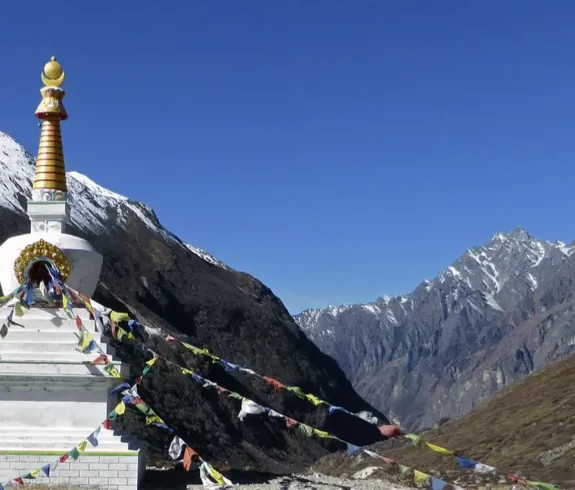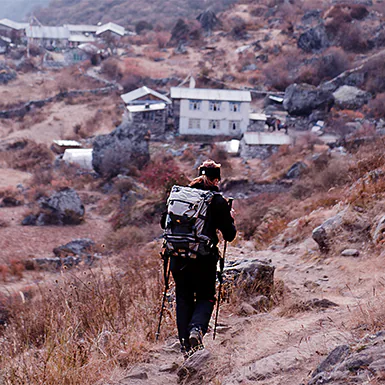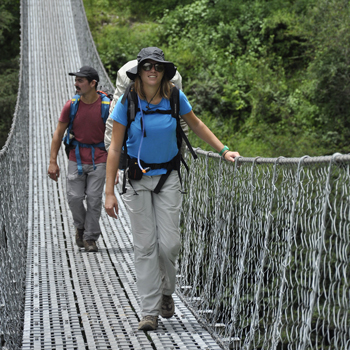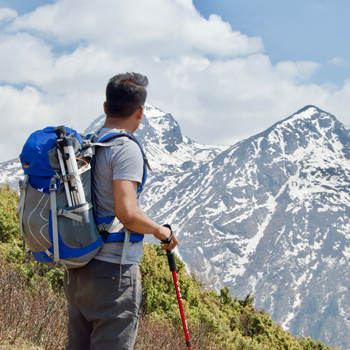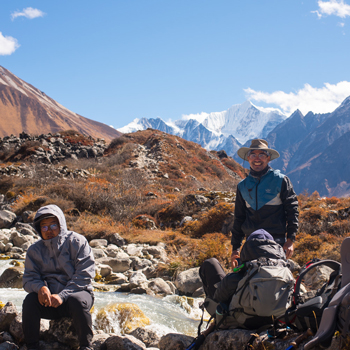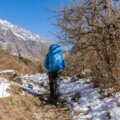Nestled between the Himalayan range and the Tibetan border, Langtang National Park is a stunning sanctuary in northern Nepal. This Park is renowned for its untouched landscapes, diverse wildlife, and deep cultural roots, making it a prime destination for those who seek to connect with nature and explore local traditions.
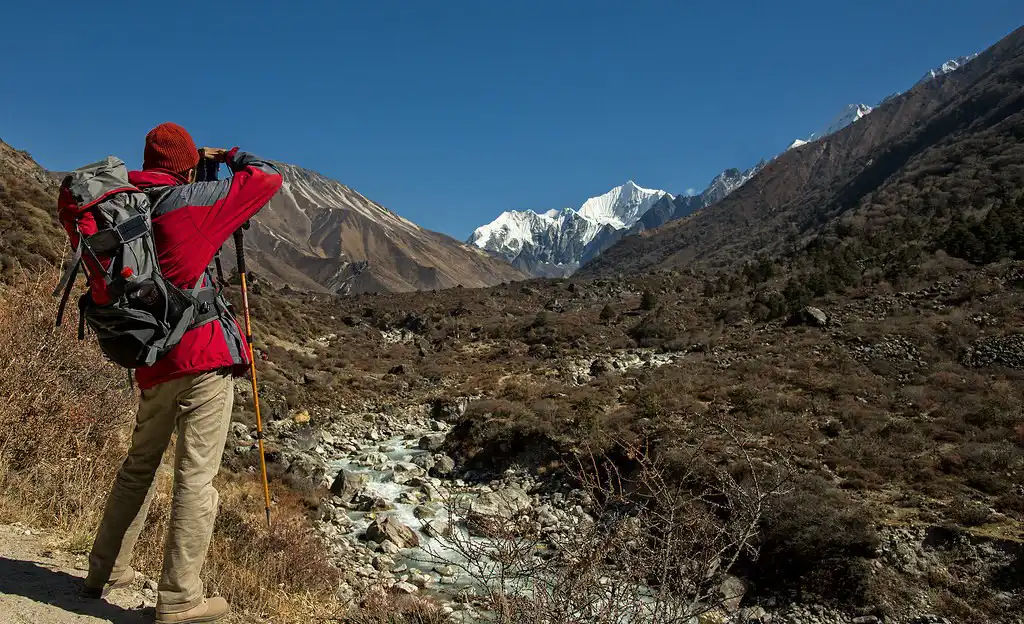
Since its establishment in 1976, Langtang National Park has been a cornerstone of Nepal’s environmental protection efforts. It safeguards various endangered species and unique ecosystems, positioning it as a pivotal area for biodiversity preservation and eco-tourism. Here are some essential details about the park’s role in conservation and its impact:
- Establishment Year: The Park was founded in 1976, marking it as one of the first national parks in Nepal.
- Geographical Extent: The Park spans an area of 1,710 square kilometers and encompasses lush tropical forests at lower altitudes, stretching to alpine pastures close to the snowline.
- Conservation Role: Langtang National Park is Nepal’s lifeline for protecting unique habitats and endangered species like the red panda, Himalayan tahr, and snow leopard.
- Cultural Heritage: It also actively preserves the cultural heritage of the Tamang and Sherpa communities, which have deep historical ties to this landscape.
- Post-Disaster Recovery: Since the 2015 earthquake, the park has undergone significant rehabilitation to revive its natural environment and tourist facilities.
Geography and Topography of Langtang National Park
Langtang National Park features an impressive range of landscapes, from deep valleys to towering peaks and flowing rivers. Its diverse geography offers visitors breathtaking views and a range of environments to explore. Below is a detailed breakdown of the park’s landscape, elevation, and geographical diversity.
Valleys
- Deep and Scenic Valleys: Langtang National Park is home to several deep, scenic valleys that offer incredible views and rich biodiversity.
- Langtang Valley: This is the most famous valley, known for its beauty, rich culture, and as a popular trekking route.
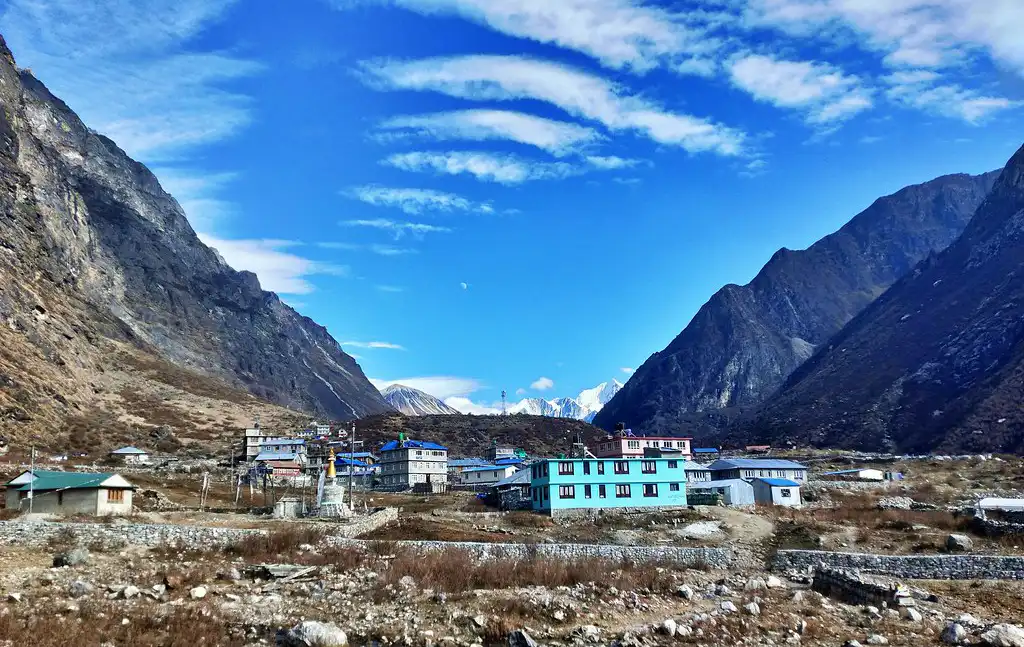
- The valley is surrounded by snow-capped peaks, creating a stunning backdrop for trekkers and photographers.
- Support for Wildlife: These valleys are home to diverse wildlife species, including red pandas and snow leopards, making them prime spots for nature lovers and wildlife photographers.
- Natural Pathways: Valleys in the park also serve as natural corridors for rivers and trekking routes, connecting various parts of the park.
Peaks
- Langtang Lirung: Standing at 7,234 meters, Langtang Lirung is the highest peak in the park. Its snow-covered summit dominates the landscape, offering a dramatic focal point for visitors and trekkers.
- Accessible for Trekkers: The surrounding peaks are scenic and accessible to experienced climbers and trekkers, providing opportunities for high-altitude adventure.
- Photogenic Landmarks: Langtang Lirung and other nearby peaks are a favorite for photographers. Many seek out Langtang National Park photos featuring the majestic mountains in the backdrop.
Rivers and Water Systems
- Langtang River: The Langtang River is a significant water source in the park, flowing through its valleys and sustaining the ecosystem.
- Glacial Rivers: Several rivers in the park originate from glaciers, contributing to the region’s dynamic geography.
- Serene Spots for Visitors: The rivers offer peaceful spots for visitors to rest and enjoy nature while trekking or camping. These water systems are essential for the park’s flora and fauna, supporting wildlife and local communities.
Elevation Range
- Wide Elevation Range: Langtang National Park is a towering giant stretching from the foothills to the snow-capped peaks. This incredible height means exploring a world of different plants and animals.
- Lowland to Alpine Zones: Lower elevations feature subtropical forests, while alpine meadows, glaciers, and rocky terrain mark higher elevations.
- Impact on Weather: The elevation range creates distinct weather patterns across the park. Visitors should check the Langtang National Park weather forecast to prepare for varying conditions, especially during trekking seasons.
Geographical Diversity
- Varied Ecosystems: The park’s diverse geography supports many ecosystems, from lush forests to alpine tundra. This biodiversity is a crucial attraction for trekkers and researchers alike.
- Flora and Fauna: The Park is home to unique plant species and endangered wildlife, including red pandas, Himalayan tahr, and snow leopards.
- Rich Cultural Landscape: Imagine stumbling upon charming villages in Langtang National Park’s heart. It’s the perfect opportunity to learn about the fascinating traditions of the Tamang and Sherpa communities.
Flora and Fauna of Langtang National Park
Langtang National Park showcases a diverse collection of flora and fauna, inviting visitors to explore a rich biodiversity unique to this region. The park’s ecosystems range from lush subtropical forests to alpine meadows, supporting a variety of rare and endemic species. Here’s an in-depth look at the park’s distinct plant and animal life.
Biodiversity Overview
- Endemic Species: Langtang National Park is renowned for its endemic species, plants, and animals native exclusively to this region. These species flourish at various altitudes, enriching the park’s ecological landscape.
- Rare Wildlife: Nothing is more soothing than the peace in this park, which is famous for being home to endangered species like the snow leopard and red panda. Visit here if you want to see these animals.
Unique Vegetation
- Subtropical Forests: Dense subtropical forests blanket the park’s lower altitudes, hosting oak, pine, and rhododendron trees. These forests are crucial ecosystems, providing habitat for numerous bird and animal species.
- Alpine Meadows: Higher up, the terrain shifts to alpine meadows, where resilient plants such as juniper and primrose thrive. In spring, these meadows are a spectacle, covered with vibrant wildflowers.
- Medicinal Plants: The Park also boasts many medicinal plants, which local communities have traditionally used for healing.
Wildlife Highlights
- Red Panda: The red panda, a cherished resident of the park’s bamboo forests, is often the highlight for visitors fortunate enough to observe this shy, arboreal creature.
- Snow Leopard: Although hard to spot, the snow leopard patrols the higher reaches of the park, a coveted sight for wildlife enthusiasts and photographers.
- Himalayan Tahr: The rugged slopes of Langtang are the roaming grounds for the Himalayan tahr, a wild goat known for its agility and adaptability to harsh terrains.
- Birdlife: Langtang National Park is a paradise for birdwatchers. Over 250 bird species, including the colorful Himalayan monal, Nepal’s national bird, enhance the park’s natural allure.
Ecosystems and Their Role
- Ecological Significance: Each ecosystem in Langtang National Park plays a fundamental role in sustaining its diverse flora and fauna. The subtropical forests act as shelters and food sources, while the alpine meadows are vital grazing areas for species like the Himalayan tahr.
- Conservation Initiatives: Because of its essential ecology, the park is the center of many conservation projects that aim to preserve its rare species and fragile ecosystems. Conservationists are continuously working to protect the habitats of endangered red pandas and snow leopards.
Weather and Climate at Langtang National Park
Understanding the weather patterns of Langtang National Park is crucial for planning your visit. The Park experiences various climatic conditions throughout the year, significantly affecting your trekking and sightseeing plans. Below, we detail the weather patterns and suggest the best times to visit based on these conditions.
Seasonal Weather Overview
- Spring (March to May): Spring is one of the best times to visit Langtang National Park. It’s generally mild here, with daytime temperatures between 10 and 20 degrees Celsius. This season is perfect for trekking as the higher trails are clear of snow, and the valleys are in full bloom, making it ideal for capturing vibrant Langtang National Park photos.
- Summer/Monsoon (June to August): Along with the warmer temperatures that summer brings, there is also the onset of the monsoon. Expect pouring rain between July and August, which can lead to trail disruptions through landslides. Trekking might be another challenge, but one will enjoy serene green scenery after the rain has elapsed.
- Autumn (September to November): Autumn rivals spring for the best time to visit the park. Langtang National Park’s stable and transparent weather offers excellent visibility and mild temperatures, which are ideal for hiking and photography. This time of year is also a peak season for visitors.
- Winter (December to February): Winters in Langtang can get cold, especially at the higher elevations. Expect freezing temperatures and lots of snow. While winter trekking is possible, it requires proper gear and precautions.
Best Times to Visit
- Optimal Trekking Conditions: Late spring (April and May) and autumn (October and November) offer the best trekking conditions. These months feature clear skies, moderate temperatures, and minimal precipitation, enhancing your experience as you explore the highlands.
- Wildlife Viewing: For wildlife enthusiasts, spring is advantageous as animals are more active and vegetation is not yet at its fullest, making animals easier to spot.
- Photography: The autumn months are ideal for capturing clear, post-monsoon landscapes. The sun’s low angle provides excellent natural lighting for stunning photographs of the terrain and wildlife.
Weather Preparation Tips
- Check Updates: Always check the latest Langtang National Park weather forecasts before and during your trip to avoid unexpected conditions.
- Pack Accordingly: Depending on the season, your packing list should include rain gear for the monsoon months and warm, layered clothing for the winter treks.
- Local Guidance: Consulting with local trekking agencies can provide up-to-date advice and adjustments to your itinerary based on recent weather conditions.
Trekking and Activities in Langtang National Park
Langtang National Park offers some of the most rewarding trekking experiences in Nepal. It features stunning landscapes, rich biodiversity, and cultural immersion. Trekkers can explore various trails, each with unique views and challenges. Below are details on popular trekking routes and necessary permits.
Langtang Valley Trek
- Overview: Langtang Valley Trek is one of Langtang National Park’s most scenic trek routes.
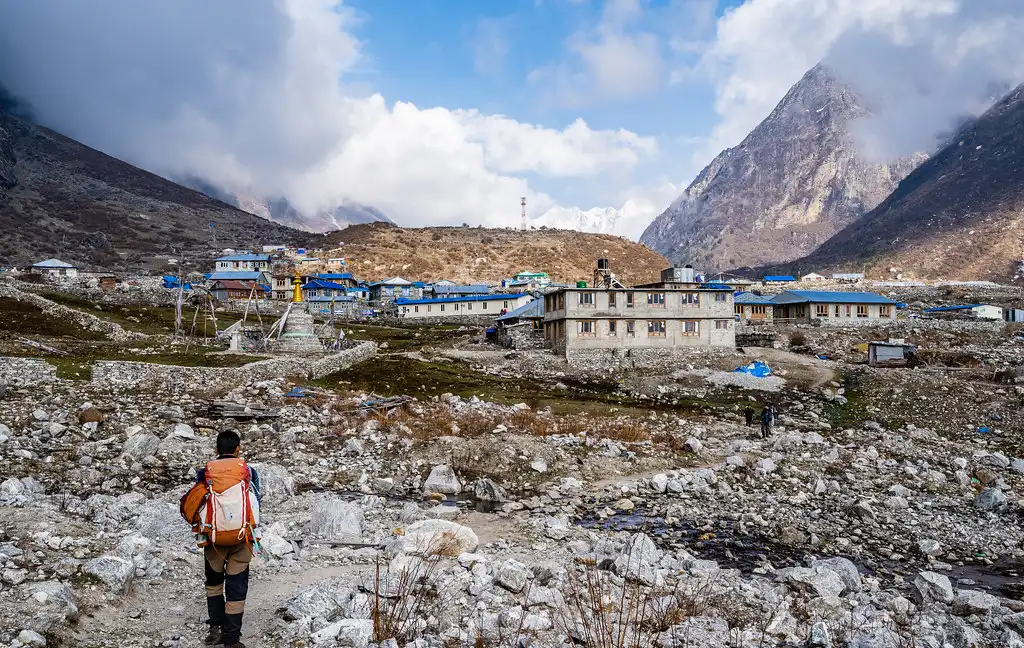
- It showcases a fantastic mixture of natural beauty in its forests, valleys, alpine meadows, and high mountains such as Langtang Lirung.
- Duration: Typically, the trek takes about 7 to 11 days, depending on the itinerary and pace.
- Highlights: The trek leads through traditional Tamang villages and ends at Kyanjin Gompa, offering incredible views of glaciers and the Langtang mountain range. For photographers, Langtang National Park photos of this route capture some of the park’s best scenery.
Gosainkunda Trek
- Overview: The Gosainkunda Trek is a spiritually significant route that takes trekkers to the sacred Gosainkunda Lake. It’s ideal for those interested in both natural beauty and cultural experiences.
- Duration: This trek takes 10 to 12 days, allowing time for acclimatization and exploration.
- Highlights: The trek passes through lush forests, crosses ridges, and reaches the high-altitude Gosainkunda Lake, a revered pilgrimage site for Hindus and Buddhists. Clear weather offers stunning views of the surrounding peaks, perfect for Langtang National Park photos.
Helambu Trek
- Overview: The Helambu Trek is less crowded than the other routes, making it perfect for trekkers seeking solitude.
- It starts near Kathmandu and meanders through beautiful landscapes and Sherpa villages.
- Duration: It typically takes 7 to 10 days, making it a relatively short trek.
- Highlights: The Helambu Trek is known for its panoramic views of the Langtang range and the chance to experience the Sherpa culture. The trail takes you through rhododendron forests, making it particularly scenic in spring.
Permits and Regulations
To trek in Langtang National Park, you need specific permits. These are necessary for both safety and conservation purposes.
TIMS Card
- All trekkers must obtain a Trekkers’ Information Management System (TIMS) card. This document helps authorities keep track of trekkers for safety reasons.
Langtang National Park Entry Permit
- Trekkers must secure an entry permit for Langtang National Park. This fee supports conservation efforts in the park and protects its delicate ecosystems.
Additional Guidelines
- Trekkers should respect local customs and follow Leave No Trace principles to preserve the area’s natural beauty.
- A local guide or porter can be a lifesaver, especially if you’re new to trekking. They know the trails like the back of their hand and can share insider tips and tricks.
Cultural Significance of Langtang National Park
Langtang National Park is a natural paradise and a vibrant cultural heritage center. It closely connects with the lifestyles and traditions of the indigenous Tamang and Sherpa communities and encompasses a variety of historical and religious sites. This guide explores the rich culture and revered sites within the park, offering valuable insights for visitors.
Exploring Local Culture
Tamang and Sherpa Communities
- Lifestyle Insights: Integral to Langtang National Park’s cultural tapestry, the Tamang and Sherpa communities invite visitors to experience their unique lifestyles, harmonizing beautifully with the natural landscape. These communities have been celebrated for their hospitality and for preserving their rich traditions for generations.
- Cultural Practices: Participating in local festivals and observing daily activities allows visitors to appreciate the community’s artistic practices better. Festivities often showcase traditional music, dance, and attire, providing a vibrant look into local customs.
Traditional Architecture
- Village Layouts: As you trek through the park, the distinctive architectural styles of mountain villages are prominent. Locals construct homes from locally sourced materials, featuring stone walls and flat roofs designed to withstand the harsh mountain weather.
- Monasteries and Chortens: The spiritual architecture, including numerous monasteries and chortens, mirrors the deep religious dedication of the local people.
Historical and Religious Sites
Monasteries
- Kyanjin Gompa: Positioned at the terminus of the Langtang Valley Trek, Kyanjin Gompa is a significant monastery offering spiritual respite and spectacular views of the surrounding mountains.
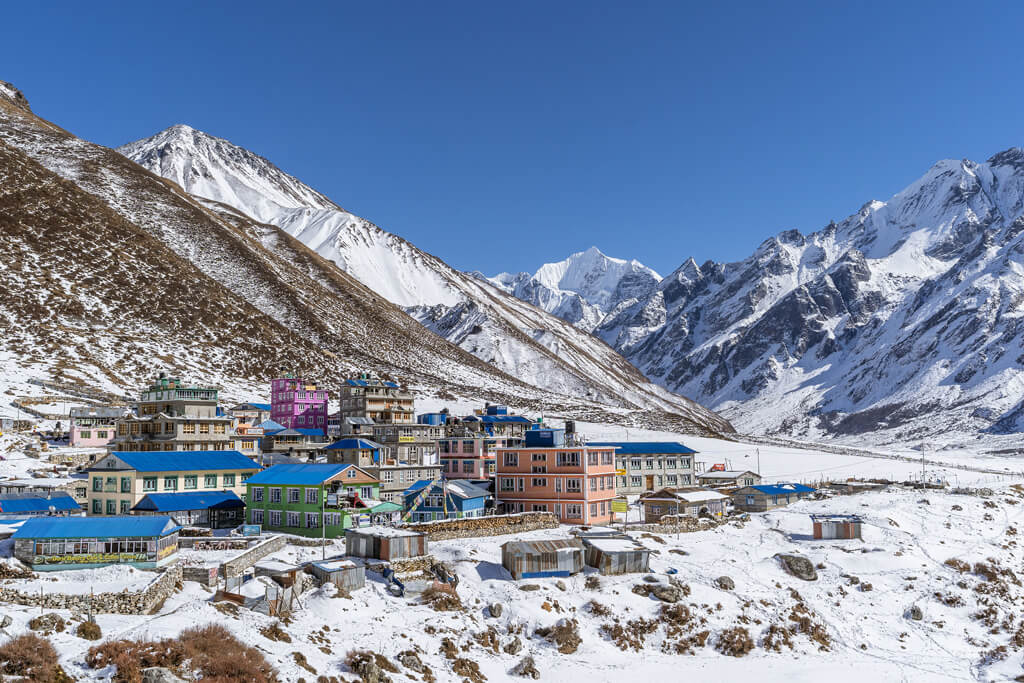
- It is a spiritual hub for the local community and a tranquil trekking stop.
- Ancient Scriptures and Artifacts: Several monasteries throughout the park safeguard ancient Buddhist scriptures and religious artifacts, some centuries old, offering a glimpse into the region’s spiritual heritage.
Sacred Lakes
- Gosainkunda Lake: As a recognized gorgeousness and a sacred place for Hindus and Buddhists, Gosainkunda Lake is supposed to have been formed by Lord Shiva. During this festival of Janai Purnima, it encounters devotees who perform ceremonial bathing and other rites.
- Spiritual Significance: Believed to possess spiritual energies, the lake and its surroundings are a focal point for pilgrims seeking spiritual blessings.
Preserving Cultural Heritage
- Community Involvement: Efforts to conserve Langtang National Park include significant involvement from local communities, ensuring that conservation measures support both natural and cultural preservation.
- Sustainable Tourism: Visitors support sustainable tourism by respecting local customs, participating in guided tours of villages, and supporting local craftspeople, which in turn aids the economic and cultural prosperity of the community.
Conservation Efforts in Langtang National Park
Langtang National Park stands out for its exceptional biodiversity and breathtaking landscapes. A series of conservation initiatives actively preserve these natural wonders, tackling the park’s ecological demands and various challenges, including recovery from natural disasters and the effects of climate change. This article explores the protective measures at Langtang National Park and the ongoing challenges that shape these efforts.
Conservation Initiatives
Protected Area Management
- Creation of Protected Zones: Langtang National Park has designated several protected zones where restrictions on human activities help reduce impacts on wildlife and ecosystems. These zones are crucial in preserving natural balance and aiding species conservation.
- Biodiversity Monitoring: Teams conduct regular biodiversity surveys and monitoring to evaluate ecosystem health and track wildlife population trends, enabling timely conservation actions.
Community Involvement
- Engagement with Local Communities: Local communities play a crucial role in the park’s conservation efforts. Community forestry and eco-tourism generate sustainable economic benefits while promoting environmental conservation.
- Education and Awareness: Programs aimed at educating locals and tourists about conservation and sustainable practices are essential in cultivating an ethos of environmental stewardship.
Wildlife Conservation
- Enforcing Anti-Poaching Measures: The Park strictly enforces anti-poaching laws to shield endangered species from illegal hunting and trapping.
- Habitat Restoration: Initiatives to restore habitats impaired by human activities or natural occurrences are vital for biodiversity preservation.
Challenges to Conservation
Recovery from Natural Disasters
- Rebuilding After the Earthquake: In response to the devastating 2015 earthquake, Langtang National Park focuses on reconstructing infrastructure and rehabilitating trekking paths, which are essential for park access and local tourism.
- Enhancing Disaster Preparedness: The Park is developing early warning systems and emergency response strategies to improve readiness for future natural disasters.
Climate Change Impacts
- Addressing Glacial Melting: The park’s higher regions face rapid glacial melting, which threatens water sources and alters habitat conditions.
- Implementing Adaptive Strategies: The Park utilizes adaptive management methods to lessen the influence of shifting climate variables, safeguarding its ecosystems and the assortment of species residing there.
Engaging with Conservation Efforts
- Visitor Participation: Visitors are encouraged to comply with park regulations, engage in eco-friendly activities, and support local enterprises, bolstering conservation efforts.
- Staying Informed: Keeping abreast of Langtang National Park weather updates and environmental developments helps visitors plan their activities and reduce their environmental impact.
Visitor Information for Langtang National Park
Langtang National Park, a magnificent destination known for its stunning landscapes and rich biodiversity, offers an unforgettable experience for nature lovers and trekkers. If you’re planning a visit, here are essential tips on how to get there, where to stay, and make the most of your trip safely and responsibly.
Getting to Langtang National Park
Travel Routes
- From Kathmandu: The trek to Langtang National Park typically starts from Kathmandu. You can take a bus or a hired vehicle to Syabrubesi, the typical starting point for treks into the park. Enjoy a relaxing drive of about 7 to 8 hours and soak up the breathtaking scenery of the Trishuli River.
- Entry Points: Syabrubesi is the gateway for most treks, including the famous Langtang Valley Trek.
Accommodation Options
Lodges and Guesthouses
- In the Villages: Numerous lodges and teahouses provide essential to comfortable accommodations throughout the trekking routes. These are great for experiencing local hospitality and cuisine.
- Near Major Trails: Guesthouses are readily available along significant trails, such as those leading to Gosainkunda or Kyanjin Gompa. They offer warm beds and hot meals.
Camping
- Camping Sites: Several designated camping sites are available for those who prefer a more immersive experience in nature. You’ll need to bring your equipment or arrange rentals through a trekking agency in Kathmandu.
Visitor Facilities
Amenities
- Basic Amenities: Most teahouses along the treks in Langtang National Park offer basic amenities, including hot showers and electricity, though these can be limited in more remote areas.
- Connectivity: Wi-Fi is available in some lodges and guesthouses, but connectivity can be spotty as you move higher.
Safety Tips and Precautions
- Acclimatization: High Altitude Sickness: When trekking above 2,500 meters, acclimatize properly to avoid altitude sickness. Plan your itinerary to include rest days or gradual ascents.
- Travel Insurance: Emergency Coverage: Ensure you have travel insurance that covers high-altitude trekking and possible helicopter evacuation in case of severe injury or illness.
- Local Guides: Hiring Guides: If you are new to high-altitude trekking, consider hiring a local guide. Guides provide valuable insights about the trails and culture and enhance your safety.
Things to Know Before Visiting
Permits
- Required Permits: Before hitting the trails, ensure you have a TIMS card and a Langtang National Park entry permit. You can get these in Kathmandu.
Best Time to Visit
- Weather Considerations: Spring and autumn are the perfect times to visit Langtang National Park. The weather is ideal, and you’ll have a fantastic experience. Always check the latest Langtang National Park weather forecasts before your trek.
Cultural Sensitivity
- Respect Local Customs: Local traditions and customs must be respected. When taking pictures of places of worship or people residing around Langtang National Park, it is necessary to dress modestly and seek prior permission.
Capturing the Beauty of Langtang National Park: A Photographer’s Guide
With its stunning landscapes and diverse wildlife, Langtang National Park is a paradise for photographers. Whether you’re an amateur looking to enhance your portfolio or a professional seeking breathtaking shots, the park offers numerous picturesque locations perfect for capturing the essence of nature. Here’s a detailed guide on the best photography spots within Langtang National Park and some practical tips for capturing the park’s majestic beauty.
Picturesque Locations for Photography
Kyanjin Gompa
- Overview: Located at the end of the Langtang Valley, Kyanjin Gompa is both a religious place and a viewpoint that offers all-encompassing views of the Langtang range.
- Best Shots: Capture the early morning light on the peaks or frame the perfect shot of the monastery with mountains in the backdrop.
Tserko Ri
- Overview: For those willing to exert more effort, the climb to Tserko Ri presents an unmatched opportunity to photograph a 360-degree Himalayan landscape.
- Best Shots: Sunrise views from Tserko Ri are legendary, illuminating the peaks with a warm golden glow.
Gosainkunda Lake
- Overview: This sacred alpine lake, surrounded by mountains, offers serene and reflective shots, ideal for those looking to capture landscape and spiritual elements.
- Best Shots: Visit during the full moon or the Janai Purnima festival for vibrant cultural photos and peaceful twilight landscapes.
Langtang Lirung Glacier
- Overview: During the summer, the glacier and its surrounding area starkly contrast ice against lush greenery.
- Best Shots: Try capturing the dynamic changes of light over the glacier, which can create dramatic and powerful imagery.
Tips for Photographers
Best Time for Photography
- Lighting Conditions: The best light for photography in Langtang National Park is during the early morning and late afternoon when the sun is low. This light offers softness and depth to landscapes and can enhance the colors of the sky and earth.
- Weather Considerations: Always check the Langtang National Park weather before heading out. Clear days offer the best visibility but don’t discount the dramatic potential of misty or overcast conditions.
Wildlife Photography
- Patience and Preparation: Wildlife in Langtang can be elusive, requiring patience and readiness to capture quick shots. Keep your camera on hand with settings pre-configured for fast action.
- Respect the Wildlife: Always maintain a safe and respectful distance from animals. A zoom lens is perfect for getting up close and personal without scaring the animals away.
Equipment Recommendations
- Lenses: A versatile zoom lens is ideal for landscapes and wildlife. A wide-angle lens can capture expansive vistas, while a macro lens is perfect for detailed flora and small fauna shots.
- Tripod: A lightweight tripod is essential for sharp images, especially in low light conditions or when shooting long exposures of the night sky or flowing water.
Conclusion: The Timeless Beauty of Langtang National Park
Langtang National Park offers an extraordinary blend of natural beauty, rich biodiversity, and cultural heritage, making it a must-visit destination for nature enthusiasts and trekkers. From the towering peaks of Langtang Lirung to the sacred waters of Gosainkunda Lake, the park provides stunning landscapes that invite exploration and photography. The wide range of wildlife and plant species enhances the experience, offering something new with each visit.
However, the park’s appeal goes beyond its scenic beauty. It is a vital hub for conservation, supporting endangered species, and preserving fragile ecosystems. Visitors can make a meaningful contribution by respecting local customs, adhering to park regulations, and supporting conservation efforts. Every visit enriches the traveler and helps protect the park for future generations.
